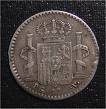 The currencies of Puerto Rico followed the development of the island closely. It was granted the use of both Spain and the United Stated because it was a colony of both countries. Puerto Rico had its own gold, but by the 16th century, the archipelago was running out of it. And because of this, a shipment of gold from the Viceroyalty of New Spain was sent to the island to provide economic support. This was called the Situado Mexicano. Unfortunately, the shipment wouldn’t arrive often and with the lack of commercial prosperity, plus natural conditions and disasters, multiplying the costs of maintaining haciendas damaged by hurricanes the economy suffered.
The currencies of Puerto Rico followed the development of the island closely. It was granted the use of both Spain and the United Stated because it was a colony of both countries. Puerto Rico had its own gold, but by the 16th century, the archipelago was running out of it. And because of this, a shipment of gold from the Viceroyalty of New Spain was sent to the island to provide economic support. This was called the Situado Mexicano. Unfortunately, the shipment wouldn’t arrive often and with the lack of commercial prosperity, plus natural conditions and disasters, multiplying the costs of maintaining haciendas damaged by hurricanes the economy suffered.
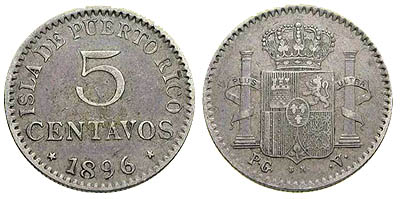
By 1766 Puerto Rico began producing banknotes becoming the first colony to print 8 real banknotes in the Spanish Empire which put them ahead of Cuba, Hispaniola and Spain by two decades. These banknotes were used throughout the island while waiting for the situado to be shipped. When it arrived, the banknotes were paid back to the Spanish Crown.
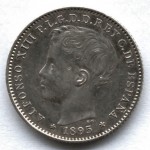 During the 19th century, the situado was discontinued because of Mexico gaining their independence from Spain, which created an economic crisis. The Colonial Governor in office, Salvador Melendez Bruna, ordered the issue of provincial banknotes, which created the Puerto Rican peso, but sometime after 1815, the notes were no longer printed. During the 1860’s and 1870’s the banknotes reemerged and on February 1, 1890, the Banco Espanol de Puerto Rico was inaugurated and began issuing banknotes. By 1895, a Royal Decree ordered the production of provincial peso coins.
During the 19th century, the situado was discontinued because of Mexico gaining their independence from Spain, which created an economic crisis. The Colonial Governor in office, Salvador Melendez Bruna, ordered the issue of provincial banknotes, which created the Puerto Rican peso, but sometime after 1815, the notes were no longer printed. During the 1860’s and 1870’s the banknotes reemerged and on February 1, 1890, the Banco Espanol de Puerto Rico was inaugurated and began issuing banknotes. By 1895, a Royal Decree ordered the production of provincial peso coins.
With the end of the Spanish-American War on August 13, 1898, Banco Espanol de Puerto Rico was renamed Bank of Porto Rico and issued bills equivalent to the United States dollar, creating the Puerto Rican dollar. After 1913, Puerto Rico’s economy and monetary system was fully integrated into the United States’ economic and monetary system. There was even a quarter coin designed with Fort San Felipe del Morro on the face of the coin.
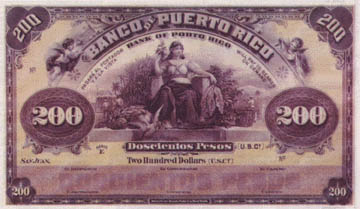
Banknotes valorized in millions continued in circulation, thus a collect was ordered and held between January 16 – 24, 1916. The remaining bills, with an estimated value of $14,872 were taken out of circulation nine years later by the Puerto Rico Commercial Bank. Objects from Puerto Rico are constantly featured in specialized magazines, in both national and international distribution. Unfortunately, the Puerto Rican dollars that were collected by the government, were burned between January 16 – 24, 1925, drastically reducing the amount of surviving notes from the Bank of Puerto Rico. The Great Depression reduced their number further, since necessity prevented the collection of pesos in large denominations. Less than five exemplars are known to exist of the 100 and 200 peso banknotes issued by El Banco Espanol de Puerto Rico and the 5 and 50 dollars Series F bills published by the Bank of Puerto Rico.
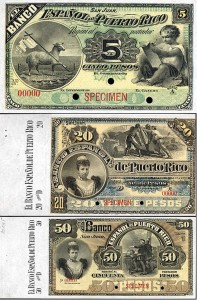 On July 10, 2005, the Liberty Dollar of Puerto Rico was introduced. Silver ounces began circulating on October 8, 2005, marking the first time that a silver coin was distributed in more than a century. In December, 2007, the United States Congress approved a measure that included the Commonwealth of Puerto Rico, Washington, D.C. and several non-autonomous territories including American Samoa, Guam and United States Virgin Islands in the 50 State Quarters program. Both commonwealths and territories were excluded from the original program approved in 1998, which was followed by almost ten years of lobbying before they were included. The design on these coins was expected to feature the same George Washington image found in the obverse of the original issues, while the reverse would depict illustrations of something characteristic to that location. The Secretary of Treasury approved the design on July 31, 2008. The coins were issued, as well as “proof coins” and 90% silver special issues. The Puerto Rico coin was the second release in 2009.
On July 10, 2005, the Liberty Dollar of Puerto Rico was introduced. Silver ounces began circulating on October 8, 2005, marking the first time that a silver coin was distributed in more than a century. In December, 2007, the United States Congress approved a measure that included the Commonwealth of Puerto Rico, Washington, D.C. and several non-autonomous territories including American Samoa, Guam and United States Virgin Islands in the 50 State Quarters program. Both commonwealths and territories were excluded from the original program approved in 1998, which was followed by almost ten years of lobbying before they were included. The design on these coins was expected to feature the same George Washington image found in the obverse of the original issues, while the reverse would depict illustrations of something characteristic to that location. The Secretary of Treasury approved the design on July 31, 2008. The coins were issued, as well as “proof coins” and 90% silver special issues. The Puerto Rico coin was the second release in 2009.

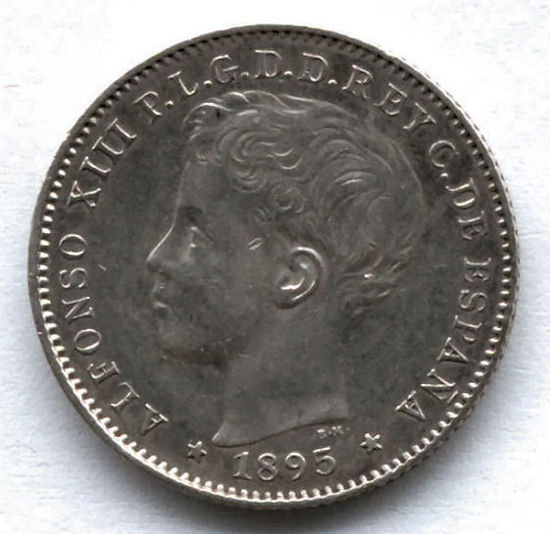

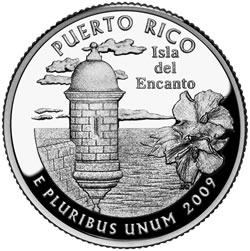
I like that. I HAVEN’T SEEN A PENNY THAT OLD. THOSE ARE BACK MEMORIES OF P.R. PENNY THAT OLD 1896. VERY NICE.